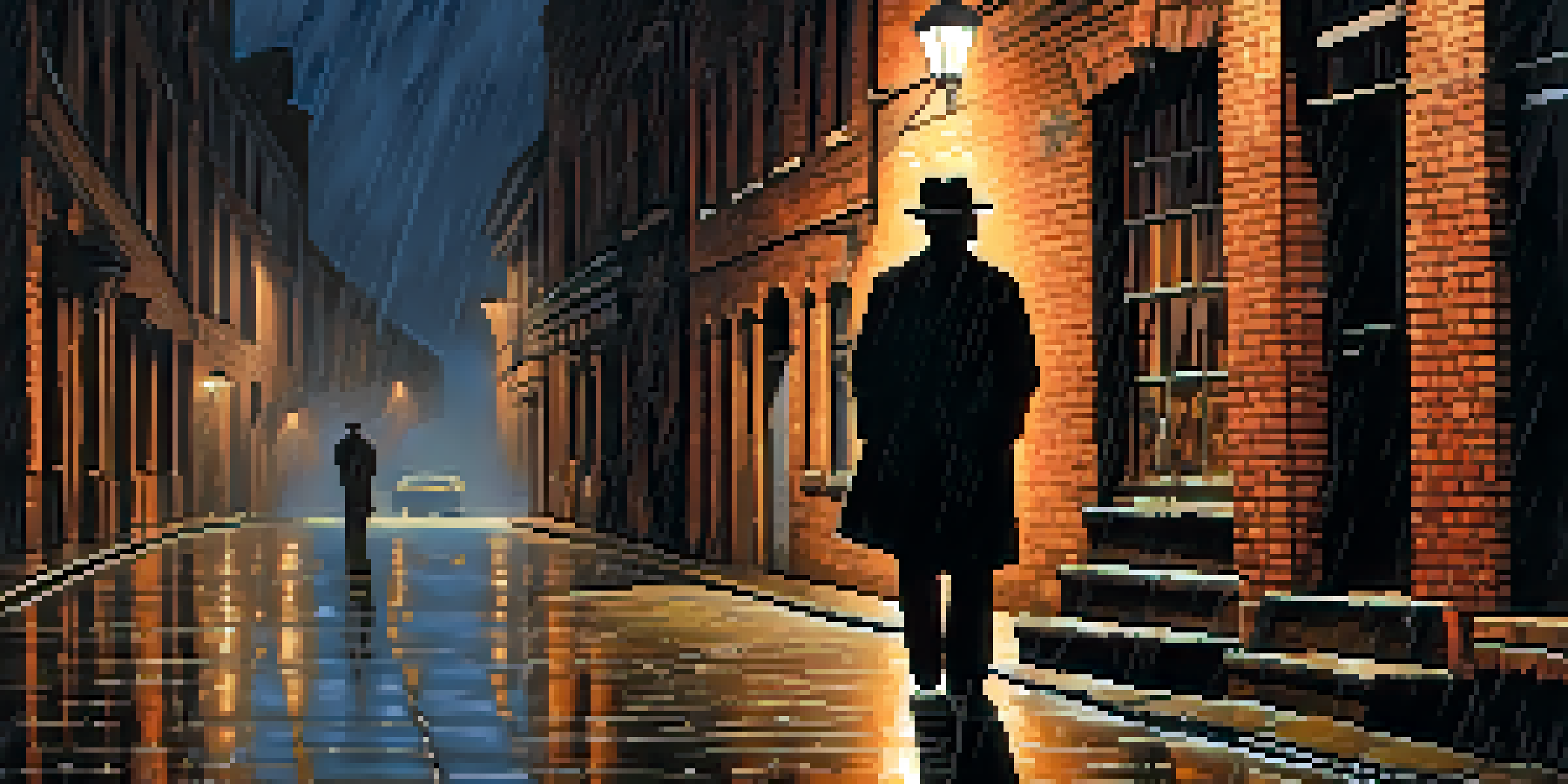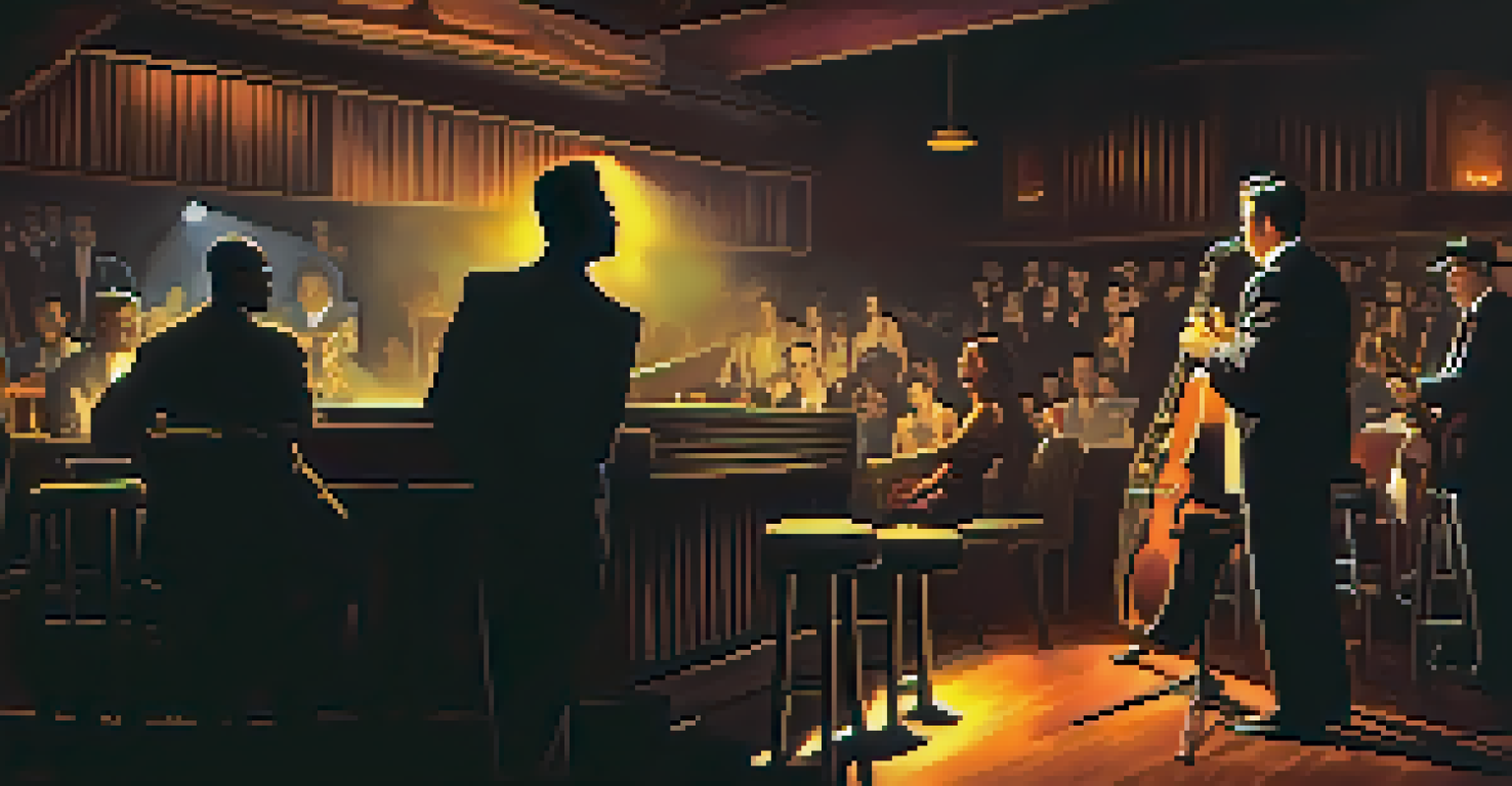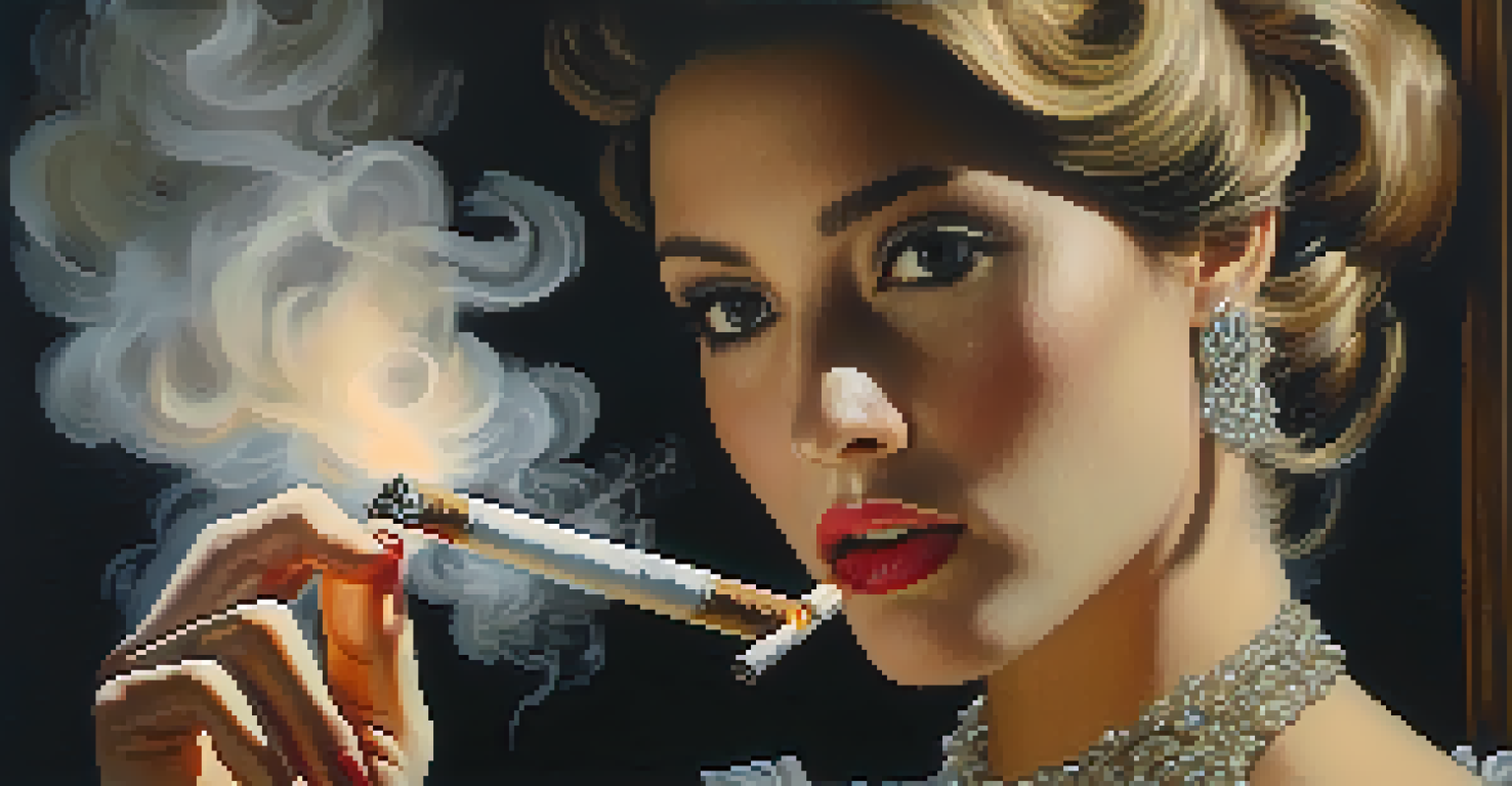Film Noir: The Dark Aesthetics and Themes of the Genre

What is Film Noir? A Brief Overview of the Genre
Film Noir is a cinematic style that emerged in the 1940s and 1950s, characterized by its dark themes and moral ambiguity. Often set against urban backdrops, these films explore the darker side of human nature, featuring protagonists who are typically flawed or anti-heroes. The term 'Film Noir' translates to 'black film' in French, hinting at the genre's shadowy visuals and bleak narratives.
Film Noir is a visual style that is as much about the shadows as it is about the light.
At its core, Film Noir often delves into themes of crime, betrayal, and existential despair. Classic examples include 'Double Indemnity' and 'The Maltese Falcon,' which showcase intricate plots and complex characters. The genre's unique blend of suspense and drama captivates audiences, inviting them into a world where nothing is as it seems.
Although Film Noir initially thrived in the mid-20th century, its influence persists today. Modern interpretations can be found in films like 'Blade Runner' and 'Sin City,' which incorporate noir elements into their storytelling. This enduring legacy highlights the genre's ability to resonate with contemporary audiences, proving that darkness can indeed be compelling.
Visual Style: The Shadows and Light of Noir
One of the most striking features of Film Noir is its distinctive visual style, which heavily relies on chiaroscuro lighting—an artistic technique using strong contrasts between light and dark. This creates a moody atmosphere that mirrors the psychological tension within the story. Filmmakers like cinematographer John Alton played a pivotal role in crafting these visually arresting scenes that have become synonymous with the genre.

The use of shadows in Film Noir serves not only to create suspense but also to symbolize the moral ambiguity of characters. For instance, the protagonist may be shown half in light and half in darkness, reflecting their conflicted nature. Such visual motifs invite viewers to ponder the complexities of good and evil, pushing them to question the motivations behind each character's actions.
Defining Film Noir's Dark Essence
Film Noir is characterized by its exploration of dark themes, moral ambiguity, and flawed protagonists against urban backdrops.
Additionally, the urban settings found in many Film Noir films contribute to the genre's overall aesthetic. Rain-soaked streets, smoky bars, and dimly lit alleyways evoke a sense of isolation and despair, reinforcing the themes of existential dread. This atmospheric backdrop becomes a character in its own right, shaping the narrative and immersing audiences in the film's world.
Common Themes: Crime, Betrayal, and Morality
Film Noir is steeped in themes of crime and betrayal, often portraying characters who grapple with moral dilemmas. The plots frequently revolve around criminal activity, whether it be a heist, murder, or deception, showcasing the consequences of these actions on the individuals involved. The complexity of these narratives invites viewers to explore the motivations behind crime and the impact on society as a whole.
Noir is a dark, mysterious world where the line between good and evil is blurred.
Another recurring theme in Film Noir is the notion of betrayal, often depicted through treacherous relationships. Characters may be driven by greed or jealousy, leading them to betray those closest to them. This theme resonates deeply, as it speaks to the fragility of trust and the darkness that can lurk within human connections.
Morality in Film Noir is seldom black and white; instead, it exists in shades of grey. This moral ambiguity challenges the audience's perceptions of right and wrong, forcing them to confront uncomfortable truths about human nature. By exploring these complex themes, Film Noir remains relevant in today's world, where ethical dilemmas continue to abound.
The Femme Fatale: A Symbol of Danger and Deception
The femme fatale is a quintessential character in Film Noir, embodying both allure and danger. This archetype is often portrayed as a seductive woman who entices the male protagonist into a web of deceit and destruction. Her motivations are typically shrouded in mystery, making her both captivating and treacherous.
Films like 'Gilda' and 'The Maltese Falcon' feature strong femme fatale characters who challenge traditional gender roles. These women are not merely objects of desire; they wield power in a male-dominated world, often using their sexuality to manipulate those around them. This complexity adds depth to their characterizations, inviting viewers to consider the societal implications of their actions.
Visual and Thematic Legacy Endures
The genre's distinctive visual style and complex themes have influenced modern cinema, inspiring films that continue to explore deception and existential dilemmas.
The femme fatale's presence in Film Noir underscores the genre's exploration of gender dynamics and the interplay of power. As audiences engage with these characters, they are prompted to reflect on the nature of attraction, trust, and the consequences of deception. Ultimately, the femme fatale remains an enduring symbol of the dark allure of Film Noir.
Soundtrack and Dialogue: The Voice of Noir
The sound design and dialogue in Film Noir play a crucial role in establishing the genre's tone and atmosphere. Often characterized by moody jazz scores and haunting melodies, the music enhances the emotional weight of the narrative. Composers like Miklós Rózsa crafted unforgettable scores that added depth and intrigue, enveloping viewers in the film's dark world.
Dialogue in Film Noir is often sharp, witty, and laden with subtext. The characters' exchanges reveal their motivations and intentions while maintaining an air of mystery. Iconic lines, like those from 'Sunset Boulevard,' have become part of cinematic history, showcasing the genre's ability to blend style with substance.
Moreover, the use of voiceover narration is a hallmark of many Film Noir classics. This technique allows for introspection, providing insight into the protagonist's thoughts and feelings. The combination of evocative music and powerful dialogue creates an immersive experience, drawing audiences into the emotional landscape of the film.
Influence of Film Noir on Modern Cinema
The impact of Film Noir on modern cinema is profound, influencing a wide array of genres and filmmakers. Its stylistic elements and thematic concerns have permeated everything from thrillers to neo-noir films, showcasing the genre's versatility. Directors like Quentin Tarantino and the Coen Brothers have drawn inspiration from Film Noir, incorporating its aesthetics and motifs into their works.
Films such as 'L.A. Confidential' and 'Chinatown' exemplify the enduring legacy of Film Noir, seamlessly blending classic elements with contemporary storytelling. These films pay homage to the genre while exploring new narratives and character dynamics, proving that the themes of deceit, obsession, and moral ambiguity remain relevant.
Femme Fatale: Power and Deception
The femme fatale archetype in Film Noir embodies the interplay of attraction and danger, challenging traditional gender roles and provoking thought on morality.
As audiences continue to engage with noir-inspired cinema, the genre's influence is likely to endure. The exploration of complex characters and dark themes resonates with viewers, allowing for a deeper understanding of the human experience. Film Noir may have originated in the mid-20th century, but its cultural significance and impact are far-reaching and timeless.
Conclusion: The Lasting Legacy of Film Noir
Film Noir has left an indelible mark on the landscape of cinema, captivating audiences with its dark aesthetics and complex themes. As we've explored, the genre's unique visual style, nuanced characters, and exploration of morality continue to resonate with viewers today. The blend of suspense, drama, and psychological depth makes Film Noir a rich area for storytelling that transcends time.
Its influence can be seen in modern films and television series, where elements of noir are woven into narratives that explore human nature's complexities. From neo-noir films to crime dramas, the essence of Film Noir lives on, inviting new generations to engage with its themes of danger, deception, and existential inquiry.

Ultimately, Film Noir serves as a reminder of the shadows that exist within us all. By examining the darker side of humanity, the genre encourages reflection on our own moral choices and the complexities of our lives. The legacy of Film Noir is not just in its films but in its ability to provoke thought and emotion long after the credits roll.